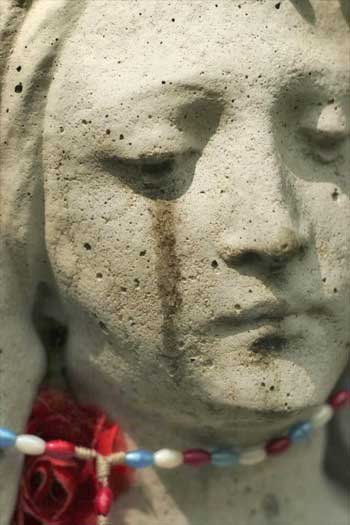Ed, in your extensive readings had you encountered Nobel Laureate, skeptic, Alexis Carrelʼs Voyage to Lourdes. I would like to read your comments on this little book.

Edward: No, but tell me a little about it. I have encountered books about healings related to a wide variety of religious beliefs, or related to weird ceremonies, placebos, visualizations, or weird health regimes (like “Jason Winterʼs Tea” that Mr. Winters believes saved him from dying from a huge inoperable tumor in his neck that was cutting off his air supply — he regained perfect health).
And I have seen a TV program on Lourdes that stated that according to the Catholic church only 40 or so cures have ever been truly miraculous, which is a pittance compared with the millions of visitors to Lourdes since the shrine was first instituted. Iʼd say the rate of spontaneous cancer cures that naturally occur each year among all the nationʼs cancer patients may be as high as the rate of documented cures among the millions that visit Lourdes each year.
I also recall reading a comment by one visitor to Lourdes who looked at the wall they have there that is filled with crutches and wheelchairs and commented, “a single wooden leg would have been more to the point.”
Speaking of miracles…
In November 1991 a Denver, Colorado, woman announced that the Blessed Virgin would appear at a Catholic shrine on Assumption Day - and that “great favors” would be rained upon those who witnessed the holy event. (She claimed that Mary had told her so in a vision.) More than six thousand people - many of them elderly and infirm - traveled to the shrine in below-freezing temperatures to witness the “miracle” and spent the entire day staring into the sky waiting for something to happen. Nothing did. But some of the pilgrims looked directly at the sun. At least two dozen people suffered permanent loss of vision; others suffered permanent loss of faith. “Did you ever hear of people going to Jesus for a miracle,” one partially blinded woman asked, “and coming away crippled?”
In 1993 Sanchez Casas, an eighteen-year-old Spanish faith healer, announced that on June 11 the Virgin Mary would appear to any of his followers who “looked directly at the sun.” On that day a thousand of his followers looked at the sun. More than thirty people were hospitalized, and at least eighteen suffered permanent vision loss. (Casas pooh-poohed the stricken as “nonbelievers” who had “stared at the sun on the wrong day.”)
- John Dollison, “Our Lady of the 1981 Camaro,” Pope - Pourri
In September 1997 more than 200 people gathered at Trinity Park in Fort Worth, Texas to stare at the sun. The event was held by a rosary group that believes the Virgin Mary has been communicating with them. The local Catholic bishop discouraged attendance. He wrote, “Although the organizers are, I believe, good people in faith. I believe they are very misguided.”
- Brian Kelcher, “Not So Good News,” The Door, No. 156, Nov./Dec. 1997
In June 1981, two teenagers were sneaking cigarettes on the side of a hill overlooking Medjugorje in Bosnia-Herzegovina when the Virgin Mary appeared to them in the clouds. Four other teenagers made similar sightings not long afterwards, and the story spread round the world. Since then more than 15 million of the faithful have made pilgrimages to the site.
Despite Medjugorjeʼs immense popularity with pilgrims, so far the church says the sightings are bunk. The Vatican officially discourages pilgrims from going there, and the local bishop has denounced the sightings as “collective hallucinations” that some Franciscan priests are exploiting in an attempt to gain control of a local parish. In a 1991 statement, nineteen of twenty Yugoslav bishops declared that “on the basis of research conducted so far, one cannot affirm that supernatural apparitions are involved.”
One major reason for the skepticism: Theologians say many messages supposedly delivered by Mary are too similar - and boring - to be authentic. “All the messages Iʼve seen from Medjugorje can be reduced to one word, conversion,” says Father Giandomenico Mucci. “One does not understand why Mary must repeat herself like that. Nor can one understand the banality of the language.”
Other reasons Catholics have doubted the authenticity of the messages:
- the necessity of having to correct the childrenʼs grammar when they were supposedly just repeating what they heard the “Virgin” say, and also the limitations of “her” vocabulary;
- the description of her having “blue eyes” which seems less compatible with the racial background of Mary than with the expectations of European children;
- the Virginʼs statement that all religions are equal;
- her displeasure at the prospect of children from the crowds “trampling on her veil,” arguably a vain rather than pious concern;
- her denial of the truth of the “Immaculate Conception.” (Joe Nickell, Looking for a Miracle)
The pilgrims keep on coming, even as civil war rages…and a cottage industry of pizza parlors, hot dog stands, and foreign exchange booths has sprung up to serve them. “The atmosphere is like Mary World,” one Florida-based pilgrim told reporters. “I spent most of my time buying rosaries.”


No comments:
Post a Comment